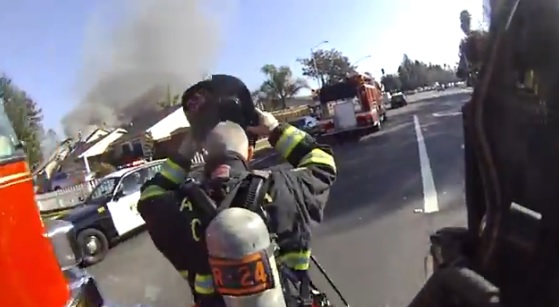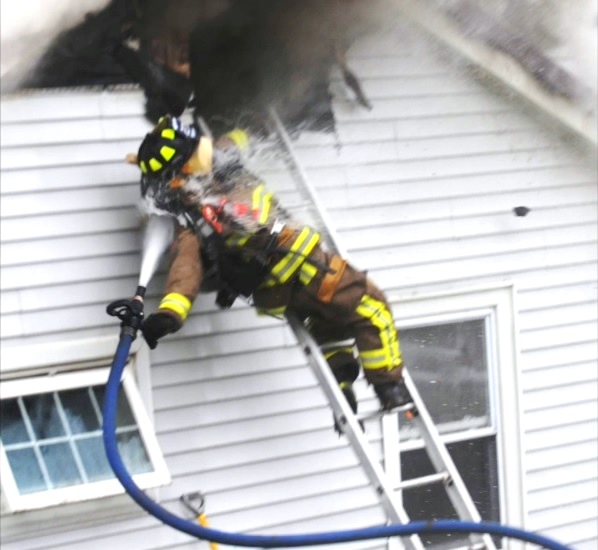Plane crash finally shows safety advantage in lightweight construction. But collapse video at fire tells the real story.
Do you want to sell a rig? Click HERE to find out how with SellFireTrucks.com.
More on Loudoun County fire from Leesburg Today
More on Fairfax County plane crash
At the top of this post, on the left, the picture from a TV news chopper of what a pilot and passenger walked away from after the plane they were in crashed into an apartment building in Herndon, Virginia early this morning. As an astute STATter911.com reader pointed out, finally we see a safety advantage of lightweight construction. If that roof had been made of dimensional lumber, those on the plane would likely have been killed or seriously injured. Okay, let’s chalk up a save for the builders.
On the right, another TV chopper picture from a few hours earlier and about 12 miles away in neighboring Loudoun County. It shows a more typical image of lightweight construction, taken during a fire. If you were a 20th century, pre-1980s firefighter and saw this before you at a single-family home wouldn’t you guess there had been something more than a fire to cause this damage and the scarring on the home next door? Maybe an explosion fueled by natural gas or propane?
Of course, that’s not the case here. It was just a typical daytime house fire in the 18900 block of Castleguard Court in the Potomac Station neighborhood near Leesburg. As you will see in the video immediately below from WJLA-TV/ABC7, the fire caused a good portion of the home to collapse.
Throughout North America, on multiple occasions each day, the building industry gets to show off the great advantages of modern home and apartment construction. While saving the lives of two people on an airplane is a rarity, the most significant advantage seems to be that builders get a second change to construct the same house all over again when fire strikes. Do you think anyone has stats for comparison on the number of complete rebuilds after pre-1980s fires versus now?
Now, listen to the discussion at yesterday’s fire in the video below from Robin B. The neighbors are all shocked at how quickly the fire spread and destroyed the home. The firefighters in Loudoun aren’t shocked. They’ve seen it time and again (see videos from 2007 and 2004 at bottom of this post). Their fire chief and many other fire chiefs in Virginia have been to Richmond repeatedly over the last 20-years, in greatly unsuccessful efforts to get the politicians to listen to the fire experts instead of the building construction lobby on issues like construction materials, home separation and residential sprinklers.
I have no clue whether any such changes would have made a difference in yesterday’s fire. What I do know is that the building industry continues to sell those who make our laws and form our codes a bunch of crap that new construction doesn’t burn any differently than old construction and that the only protection the public needs is a smoke alarm (something the industry told us we DIDN’T need in the 1970s).
It’s time the citizens, particularly those who have lost their modern home to fire or had homes damaged because of a fire in a neighbor’s house, start their own lobby. They need to show up in Richmond and every other state capital and demand that if they can’t have homes that don’t crumble under routine fire conditions, that at least they should be protected by residential sprinklers, more distance from their neighbor’s home and outside wall assemblies that reduce fire spread.
I know I’m in a fantasy world and just dreaming. The citizens aren’t going to rise up. Even if they did they don’t have the money behind them and the clout of the building lobby. But those of us who are old enough, all dreamed way back in the mid-20th century that, by now, we would be living in a world similar to the cartoon show “The Jetsons”. We would all have robot maids, flying vehicles and, of course, Skypad Apartments. Instead, our so-called modern homes aren’t based on 21st century ideas. They are really throwbacks to the 19th and 18th centuries to a time before we figured out there were actually things we could do to slow down the spread of fire in an effort to keep homes and communities from being destroyed.
To sum up, the smartest engineering minds in the construction industry came up with buildings and homes that have been proven to save lives in the event of a plane hitting the roof. Hooray for them. But if fire strikes, you’re just screwed.
Click here to follow STATter911.com on Facebook (hit “like”)








